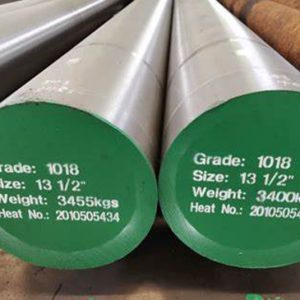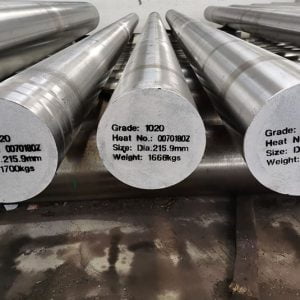Introduction

In the realm of industrial materials, 1018 hot rolled steel stands out as a versatile and widely-used option. Its properties and applications span across various industries, making it a cornerstone in construction, manufacturing, and beyond. In this blog post, we delve into the characteristics, applications, and benefits of 1018 hot rolled steel.
Understanding 1018 Hot Rolled Steel
1018 hot rolled steel is indeed a versatile material renowned for its numerous advantageous properties. Let’s delve deeper into each of its key characteristics to understand why it’s such a popular choice across industries.
Excellent Weldability: One of the standout features of 1018 hot rolled steel is its exceptional weldability. This means that it can be easily welded using commonly employed welding methods such as arc welding, MIG welding, and TIG welding. The low carbon content of 1018 steel reduces the risk of brittleness and cracking during the welding process, resulting in strong and reliable weld joints. This property makes it a preferred material for fabricators and manufacturers who require seamless assembly of components.
Superior Machinability: Machinability refers to the ease with which a material can be machined or shaped using various cutting and shaping processes such as drilling, milling, turning, and grinding. 1018 hot rolled steel is highly regarded for its superior machinability, which stems from its uniform composition and fine grain structure. This allows for precise machining with minimal tool wear, resulting in high-quality finished products. From intricate parts to complex components, 1018 steel can be machined with ease, making it a preferred choice for manufacturing applications.
Formability: Another notable attribute of 1018 hot rolled steel is its excellent formability. Formability refers to the ability of a material to be formed or shaped into desired shapes and configurations without fracturing or exhibiting excessive deformation. Due to its low carbon content and homogeneous microstructure, 1018 steel exhibits good ductility, allowing it to be easily bent, stretched, or stamped into various forms without experiencing significant deformation or cracking. This makes it well-suited for applications that require complex geometries or intricate designs, such as automotive body panels, enclosures, and structural components.
Smooth Surface Finish: The hot rolling process used to manufacture 1018 steel results in a smooth surface finish that enhances its aesthetic appeal and functional performance. Unlike cold-rolled steel, which may exhibit surface imperfections or irregularities, hot-rolled 1018 steel features a uniform surface texture that is free from scale, oxide layers, or other surface defects. This not only improves the appearance of finished products but also ensures consistent material properties and dimensional accuracy. The smooth surface finish of 1018 steel makes it suitable for applications where aesthetics and surface quality are important considerations, such as architectural components, decorative fixtures, and consumer goods.
Enhanced Mechanical Properties: In addition to its favorable welding, machinability, formability, and surface finish, 1018 hot rolled steel also boasts enhanced mechanical properties that contribute to its overall performance and reliability. Despite its relatively low carbon content, 1018 steel offers good tensile strength, yield strength, and hardness, allowing it to withstand moderate loads and stresses without deforming or failing. This combination of mechanical properties makes it a versatile material for structural, mechanical, and engineering applications where strength, durability, and performance are paramount.
In summary, 1018 hot rolled steel is prized for its excellent weldability, machinability, formability, smooth surface finish, and enhanced mechanical properties. These qualities make it a preferred choice for a wide range of applications across industries, from construction and manufacturing to automotive and consumer goods. Whe
Applications Across Industries
Construction Sector
In the construction industry, 1018 hot rolled steel finds extensive use in structural components such as beams, columns, and channels. Its combination of strength and formability makes it ideal for fabricating frameworks and support structures in buildings, bridges, and infrastructure projects.
Manufacturing and Fabrication
Manufacturers and fabricators appreciate the versatility of 1018 hot rolled steel in producing a wide range of components and parts. From machine parts and tools to brackets and hardware, its machinability allows for precise shaping and customization to meet specific requirements.
Mechanical Properties and Performance
1018 hot rolled steel exhibits favorable mechanical properties that contribute to its widespread adoption. Its moderate tensile strength and good ductility enable it to withstand moderate loads and stresses without compromising structural integrity. Additionally, its weldability facilitates efficient assembly and fabrication processes.
Case Studies: Real-World Applications
To illustrate the practical use of 1018 hot rolled steel, let’s examine a few case studies:

| Application | Description |
|---|---|
| Automotive Frames | 1018 hot rolled steel is commonly employed in the fabrication of automotive frames due to its strength, formability, and cost-effectiveness. |
| Agricultural Equipment | Manufacturers of agricultural machinery utilize 1018 hot rolled steel for components such as chassis, brackets, and implements, benefiting from its versatility and durability in demanding environments. |
| Structural Supports | In industrial facilities and warehouses, 1018 hot rolled steel serves as a reliable choice for structural supports, offering stability and load-bearing capacity for heavy equipment and machinery. |
Conclusion
In conclusion, the versatility of 1018 hot rolled steel makes it an indispensable material across various industries. Its combination of strength, formability, and affordability renders it suitable for an array of applications, from construction to manufacturing. Understanding its properties and performance enables engineers and designers to leverage its benefits effectively, contributing to the advancement of diverse projects and products.
FAQ
Q:What are the key properties of 1018 hot rolled steel?
A:1018 hot rolled steel is characterized by its low carbon content, good weldability, machinability, and formability.
Q:What are the typical applications of 1018 hot rolled steel?
A:It is commonly used in construction for structural components, in manufacturing for various parts and components, and in automotive and agricultural machinery.
Q:How does 1018 hot rolled steel compare to other steel grades?
A:Compared to higher carbon steels, 1018 hot rolled steel offers improved weldability and machinability but may have slightly lower strength and hardness.
This blog post provides an overview of the versatility and applications of 1018 hot rolled steel, shedding light on its importance in modern engineering and manufacturing landscapes.





